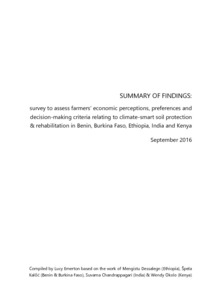Survey to assess farmers’ economic perceptions, preferences and decision-making criteria relating to climate-smart soil protection & rehabilitation in Benin, Burkina Faso, Ethiopia, India and Kenya
Key findings
This document reports on a study to assess farmers’ economic perceptions, preferences and decision-making criteria relating climate-smart soil protection and rehabilitation (CSS) measures in Benin, Burkina Faso, Ethiopia, India and Kenya. Specifically, it aims to answer the question: what do farmers perceive as the key costs, benefits, barriers and enabling conditions that influence their uptake (or rejection) of different land management practices? The study applies the Evaluating Land Management Options (ELMO) tool, a participatory method that has been developed by CIAT to investigate farmers’ own perceptions and explanations of the advantages, disadvantages and trade-offs associated with different land management choices as they relate to their needs, aspirations, opportunities and constraints.
The study is able to highlight farmers’ preferences for different CSS measures in the five study sites, as well as to identify the main inputs, outcomes, barriers and enabling conditions that influence their uptake (or rejection) of different land management practices. While there remain key differences between (and within) the study sites, a number of common lessons emerge which relate to the assessment and design of CSS measures.
One is the need to take account of farmers’ constraints and limitations as concerns their ability to access the cash, labour and technical knowhow that are required to implement new land management practices. Even when a land management technique may be perceived to be of great interest and high potential benefit, many farmers are simply not in a position to allocate the extra inputs that are required to implement it. The other is to recognise that most farmers do not merely strive to achieve one outcome or maximise a single stream of benefits when they make land management choices. Rather, it is the array of values, and the interactions between them, that matter and shape their preferences. The most desirable and viable land management alternatives are seen to be those which not only increase the flow of physical products (for example cash, food and other items), but also enhance livelihood diversity and security (such as filling critical food and cash gaps over the course of the year), at the same time as helping to secure longer-term improvements in the production base (most importantly soil fertility and moisture).
The study findings serve to underline the fact that the most preferred land management are not necessarily those that yield the highest production gains, generate the greatest income, or entail the lowest costs (the characteristics that would traditionally be deemed important when land management interventions are designed). The metrics that are used to determine the desirability and viability of different land management options, measure their desired effects, and weigh up their advantages and disadvantages do not just concern cash costs and benefits or physical inputs and outputs, but encompass a wide array of monetary and non-monetary factors (such as the type and diversity of benefits generated and costs incurred, their timing, certainty, risk and relative ease of delivery). Unless these broader needs, constraints and preferences are identified, and addressed in the land management ‘solutions’ that are presented to farmers, CSS measures are unlikely to be acceptable, effective or sustainable in practice.

